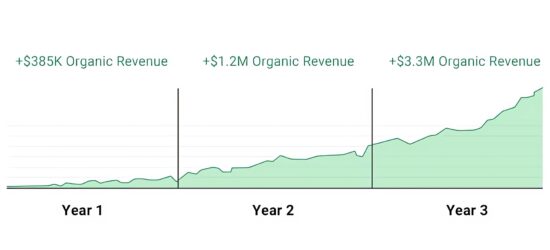Clients are asking AI engines right now: ‘Where can I legalise my documents?’ or ‘Best certified translator near me’. Will they find you or your competitor?
Get discovered and secure more clients with a multilingual SEO + GEO strategy optimised for translation agencies, legalisation firms, and notary services.
Genurion’s data-driven approach ensures you rank high in Google and get cited in AI responses from ChatGPT and Perplexity. We cut through the noise to deliver measurable results: more inquiries, higher conversions, and proven ROI. Simple and to the point – just clear metrics on:
- New client acquisitions from organic search
- Performance tracking and optimisations
Who We Help
Translation and legalisation services are diverse, but they all face the same challenge – being found online when clients urgently need certified documents. We help every part of this industry get discovered and chosen.
Certified Translators
We help sworn and certified translators show up for high-intent searches like “sworn translator German to English” or “certified translation for visa.” With structured data and GEO, your services get cited in AI answers where clients ask for document translation services.
Notary Services
If notaries or public institutions provide certified translations, our local SEO and GEO strategies connect them to nearby clients searching for official document services.
Legalization Agencies
Agencies that handle apostilles, notarisation, or consular legalisation need visibility for time-sensitive queries. We optimise so when someone asks, “How do I legalise my birth certificate for Spain?” your business is the one AI and Google recommend.
Law Firms Offering Translation
Law firms with in-house translators or partnerships often get overlooked online. We highlight your expertise in legal translation and compliance, so you’re cited when users search or ask AI for “legal contract translation” or “court document translator.”
Why These Businesses Need SEO & GEO
Why Your Business Needs SEO & GEO
In an era of rising global trade and migration, where document accuracy can make or break deals, a basic website won’t cut it. SEO gets you found in traditional searches, while GEO makes sure you’re recommended in AI conversations, which is vital since 40% of users now start with AI queries.
Here’s why this combined strategy is essential:
Vast User Base = Massive Addressable Opportunity
- As of 2024, over 304 million people are international migrants globally. This number has grown by over 30 million in just the last 5 years, with Western Europe and North America seeing the largest annual increases. (MPI)
- The total number of forcibly displaced people (including refugees, asylum seekers, and internally displaced persons) exceeded 122 million in 2025, with millions of new cases occurring each year. (WHO)
- Ranking #1 on Google results yields 27.6%–39.8% of all clicks, while only 0.63% of users click second-page results; websites cited and recommended in AI engines like ChatGPT and Perplexity see up to 2x higher click-through and direct engagement rates compared to traditional SERP-only visibility. (Backlinko)
SEO Delivers Exceptional ROI
- On average, SEO campaigns begin to show positive ROI in 6–14 months, with peak returns often in years 2 or 3, averaging an ROI in the range of 530% to 750%. (First Page Sage)
- As GEO is still a new movement and is still maturing, there aren’t years-long benchmarks, but early results signal an average ROI range from 200% to 500% within 6-12 months. (Hashmeta)
Clients Will Expect It! AI SEO + GEO Is the Next Frontier
- This is now an expectation: AI SEO and GEO are fast becoming the industry standard in client acquisition and digital visibility.
- The business that appears in AI responses is the one that captures the user’s attention, as users rely more and more on AI assistants like ChatGPT and Perplexity to answer their questions instead of using traditional search engines.
- Not becoming one of the trusted sources cited by AI means risking digital invisibility, even if top Google rankings have been achieved.
Among you and your competitors, the one that gets cited is the one that actually gets picked.
Target High-Intent Traffic for Lower Costs and Higher Conversions
- Unlike generic branding or awareness campaigns, SEO + GEO for translation and legalisation services target people who are already searching or asking AI for help with certified translations, apostilles, or document legalisation.
- That means each visitor is highly motivated to make a purchase, with far fewer clicks wasted on casual browsing.
- For example, someone typing “certified translation of birth certificate for Spain” or asking “where to get an apostille for university diploma” is already halfway to hiring. You just need to be visible at that moment.
FAQ
Translation & Legalisation SEO + GEO means optimising your company’s online presence to show up for both search engines (SEO) and AI engines (GEO) like ChatGPT. So you’re found and recommended when clients seek certified translators, apostille services, or notarisation.
Most agencies see measurable increases in search and AI-driven inquiries within 3–6 months. Peak ROI commonly 530% to 750% for SEO, typically occurs between 12 and 36 months, while GEO campaigns see 200%–500% early gains as AI citation features mature.
SEO + GEO works for any size operation. Local providers and individual certified translators can achieve first-page and AI-citation status even in competitive markets using structured data, targeted local keywords (“certified translation near me”), expert content, and backlinks.
Every campaign is backed by clear analytics:
- Volume of new inquiries tracked by channel
- Rankings in Google and the AI engine “Overview” or citation features
- Engagement metrics (CTR, bounce, conversion rates)
- Attribution dashboards connecting results to specific campaigns
No SEO or GEO provider can ethically guarantee a number one ranking or citation. What we do guarantee: our campaigns use industry-best practices, custom research, and ongoing optimisation to maximise your visibility and conversion rates, backed by transparent reporting.






